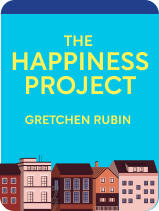

This article is an excerpt from the Shortform book guide to "The Happiness Project" by Gretchen Rubin. Shortform has the world's best summaries and analyses of books you should be reading.
Like this article? Sign up for a free trial here .
What is Gretchen Ruben’s book The Happiness Project about? How can making small, seemingly insignificant changes to your daily routine help you live a happier, more fulfilling life?
Gretchen Rubin spent a year examining how to become happier in her everyday life by improving different areas in small ways each month—a practice she calls the “happiness project.” In the book, she explains how you can create your own happiness project, a year-long quest to add more happiness to your life by making simple tweaks to your daily routine.
Here is a brief overview of Gretchen Ruben’s bestselling book The Happiness Project.
The Happiness Project by Gretchen Rubin
In her book The Happiness Project, Gretchen Rubin explains how making the smallest of changes to your everyday life can translate into more vivid memories, stronger relationships, and a deeper sense of happiness. In doing so, you’ll live up to your potential, spend less time dwelling on negativity and setbacks, and boost the happiness of those around you.
Below is a brief overview of Gretchen Rubin’s book The Happiness Project, summarizing each of the twelve month’s happiness resolutions.
Month 1: Get More Energy
Focusing on your energy—both physical and mental—is a vital starting point because the more energy you have, the more motivated you’ll be to stick with your long-term project.
Physical Energy Boosters
Boost your physical energy in two key ways:
- Get better sleep by optimizing your environment—lower your lights at night and avoid stimulating activities like video games right before bed. Additionally, question if you really enjoy doing things late at night—and push them off to the weekend if possible.
- Exercise more—look for workout routines you’ll genuinely enjoy and find ways to sneak exercise into your everyday life. Find a friend who loves their exercise routine, and try it out for yourself. Additionally, commit to walking more. For example, if you need to run errands in nearby locations, walk instead of driving.
Mental Energy Boosters
Your surroundings have a strong bearing on your attitude, feelings of calm, and energy. Boost your mental energy in two ways:.
- Eliminatie physical clutter. This creates happiness by eliminating negative feelings like frustration, such as when you can’t find what you’re looking for. Furthermore, though you have fewer belongings in the end, they’re the belongings that you use and really like.
- Eliminate mental clutter. Tackling a list of your incomplete tasks eliminates the overwhelm and guilt that you experience when thinking about all you haven’t done.
Month 2: Improve Your Relationship
Your relationship, and its happiness, touches all aspects of your life. There are four significant ways you can increase happiness in your relationship.
1) Stop Nagging
Nagging doesn’t make your partner do what you want—it just creates resentment for both parties. On the other hand, not nagging maintains a pleasant mood between you. To achieve this:
- Commit to not nagging. If the task is time-sensitive, do it yourself. If it’s not time-sensitive, let them do the task on their schedule.
- Acknowledge your partner’s contribution. You may be taking for granted how much your partner does around the house. For example, you may cook dinner every night, but don’t appreciate that your partner cleans the apartment top to bottom every week.
2) Let Go of Expectations
When you expect someone’s praise or acknowledgment and don’t get it, you’re likely to end up feeling resentful. To avoid this, stop expecting praise.
- Instead of doing things for others, do things for yourself. For example, while cleaning up after dinner, tell yourself, “I’m cleaning the kitchen tonight because I want to wake up to a clean house.”
3) Improve Communication
Relationship conflicts are inevitable. Common-sense keys to handling them constructively include: not bringing up issues from the past, avoiding absolutes (“never” and “always”), taking breaks from arguments, and recognizing what might be affecting your partner’s mood.
Additionally, keep communication positive by not unloading minor problems, irritations, or insecurities on your partner. Moods are contagious in relationships—when you approach your partner with gripes and negativity, they’ll mirror your emotions. Instead, consider how a complaint could be said more positively—or if it needs to be said at all.
4) Show Love
Though you might feel love, it won’t matter unless your partner sees it in actions that demonstrate love and appreciation. The most effective way to show someone that you care is to emulate the actions that they use to show love and care. For example, if your spouse always throws big parties for his friends’ milestones, help his friends organize a party for his birthday.
Month 3: Happiness at Work
Happiness at work is crucial to life satisfaction because you spend so much of your life there, and it can be a regular source of fulfillment, growth, socializing, and recognition.
Find the Right Work
Enthusiasm for your work drives you to master your skills, which gives you a competitive advantage over others. To find the type of work you enjoy, ask yourself what you do in your free time. Consider the free-time activities you genuinely like and put aside those you pretend to enjoy because they seem prestigious or successful.
Leave Your Comfort Zone
Once you’re in the right work, you can focus more on enhancing your fulfillment and creativity by leaving your comfort zone. There are three ways to meaningfully accomplish this.
- Start a new project that aligns with what you already like to do—for example, writing a new book, taking classes to help you switch careers, or starting a club. This gives you a chance to network with people who share your interests.
- Embrace failure and think about how it’s necessary for growth and ambition. Tell yourself that failure is exciting because it demonstrates that you’re doing something worth doing.
- Create a goals group. You’ll likely come to a point where you need help with your project. One effective way to ask for help is to form a group of people who are working towards similar goals. This gives you a safe place to discuss ideas and get feedback.
Month 4: The Joys of Parenting
This month, focus on the overall happy experience of parenting and let the smaller negative moments slide. Your children won’t stay children forever, so the time to maximize your home’s happiness is now. There are a few ways to accomplish this.
1) Change How You Communicate
It’s tempting to stop your kids from messing around or raise your voice when dealing with unpleasant or stressful tasks. If you find ways to lighten up these moments, everyone—including you—will be happier.
- Look for a pleasant edge to add to an unpleasant task. For example, Rubin started singing in the morning to wake up her children. She found that it started everyone’s day more pleasantly.
- Deflect whining. Find positive ways to distract a whining kid, instead of raising your voice at them. For example, you might make a silly rhyme or story of their complaints.
- Reframe your thinking when faced with a difficult or frustrating task. Tell yourself you enjoy it. For example, you might say, “I’m happy to take my kids to karate class. It’s fun to watch them learn.”
2) Make More Happy Memories
You can create more happy memories for yourself and your children if you engage more fully in the now by not rushing projects, and consider the future by preserving happy memories.
- Don’t rush projects. Patiently doing projects at your child’s inefficient pace maximizes the happiness of the experience in two ways. First, you get to fully savor the experience, which gives you vivid, happy memories to reflect on. Second, a child’s pace can remind you of joy that you overlook as an adult. For example, at Christmas, you’re usually focused on the stress of the holiday season. But working on a gift with your daughter reminds you of the anticipation and joy that surround the holiday.
- Preserve happy memories. To help preserve memories for your loved ones, pay attention to how they choose to reminisce. For example, if your spouse loves looking at photos, and your children always talk about family traditions, create yearly photo albums and hold onto small relics of your traditions like Halloween costumes, or “first day of school” photos.
Month 5: Improve Your Leisure Time
In our busy, ambitious lives, it’s easy to either forget about play or only engage in play that feels productive in some way. This month, resolve to do more activities purely for fun—not for the sake of productivity. There are two methods to add more fun to your life.
Method #1: Seek Out More of What’s Fun for You
It’s possible that like many people, you participate in activities that you think you should enjoy instead of activities you actually enjoy. There are three parts to having more genuine fun.
- Cull your current “fun” activities. Consider what you do for fun, then for each activity, ask yourself: Do I look forward to doing this activity? Does it make me feel energized or drained?
- Think of new ways to have fun. Try writing down the ways you had fun as a child. It’s likely that what was fun for you then will still be fun for you now. Or, you might look for new experiences by checking out the bulletin boards in cafés you haven’t visited before.
- Embrace your idea of fun and talk about it with others. Talking about your interests opens up opportunities to connect with like-minded people. This gives you a new group of people to meet up with, adding genuinely fun events to your life.
Method #2: Allow Time for Goofiness
Many people shut down goofiness when they’re trying to be efficient—even when there’s no need for efficiency, such as bathtime or Saturday morning breakfast. When you catch yourself shutting down play in the interest of unnecessary efficiency, ask yourself: Does this need to be done now? Can we spare a moment to be goofy? Taking a minute to joke around stops you from nagging or arguing, boosting everyone’s mood.
Month 6: Strengthen Your Friendships
Friendship and social bonds are well-known contributors to overall happiness and life satisfaction. Two meaningful exercises make friendships stronger and happier.
Exercise #1: Make the Effort
The work of maintaining friendship is easily pushed aside in the context of everyday life. Make an effort to stay in touch and show up for your friends.
- To better keep in touch, come up with a plan to contact friends more regularly. You might call one each Saturday afternoon, or set a few dates in your calendar as “check-in” days.
- Showing up looks like visiting your friend after they have a baby, or going to friends’ events. Showing up for important moments in others’ lives naturally strengthens your bonds with them.
Exercise #2: Cultivate a Generous Spirit
Being generous toward your friends often gives you just as much happiness as it gives them, so practice generosity of spirit. Some ways to cultivate a generous spirit include: encouraging your friends to pursue their goals; helping your friends make connections with others; helping your friends in ways that are enjoyable to you, such as gardening or résumé editing; and remembering to consider external factors that might be affecting your friends’ actions or attitude.
Month 7: Optimize Your Spending
The key to a happy relationship with money is spending your money in meaningful ways that make you feel good and contribute to your growth.
Meaningful Spending Exercise #1: Splurging in Small, Happy Ways
Indulge in small, meaningful splurges. Everyone’s idea of “meaningful” splurging is different.
One of the most important factors to indulging in splurges is rarity. If you indulge too frequently in something, you get used to it and it no longer feels like a treat.
Meaningful Spending Exercise #2: Buying What You Need, Using What You Have
Most people are either underbuyers—who only shop when they’ve run out of necessities like toilet paper—or overbuyers—who buy and waste huge supplies of possible needs like allergy medicine. No matter which type of buyer you are, simply buying what you need can make you happier and less stressed. Underbuyers can stock up on items they’re always running out of, and overbuyers can cut back on unnecessary or wasteful purchases.
Another simple way to increase your happiness is to stop hoarding material things for “someday.” First, because “someday” might never come—you might lose the item, or you could pass away before enjoying it. Second, not using something is just as wasteful as directly throwing it out. Seek out ways to use the “good” dishes or use up your fancy stationery.
Meaningful Spending Exercise #3: Refraining From Unhappy Spending
Cut spending that feels bad out of your life. For example, feel-bad spending might include buying cigarettes or ordering takeout every night. Keep in mind that not all spending is monetary—cut out unfulfilling ways you’re spending your time, such as reading Facebook comments, sleeping in late, or putting effort into a one-sided friendship.
Month 8: Cultivate Happiness
This month’s practices will help you cultivate gratitude for your everyday life. There are two significant ways to cultivate this deeper happiness.
Method #1: Seek Reminders of Your Good Fortune
Major life changes and catastrophes can happen to anyone, at any time. Reflect on how good your current reality is and recognize how you take it for granted.
- Examine life’s fragility to adjust your perspective and see how good your life is. Do some experimenting to find your own way to reflect on life and death. For example, you might take hikes in different seasons to contemplate nature’s cycle, read books about people’s experiences with catastrophe or loss, or read obituaries.
- Create a gratitude log. Consistent gratitude helps you feel more satisfied with what you already have. Try keeping a journal or blog, or record a short video each day.
- Reframe your thinking. When you feel annoyed or overwhelmed, express gratitude for the experience. For example, instead of, “I’m tired. I don’t want to make dinner for the kids,” try, “I’m grateful that I have enough food in the house to pull together a meal.”
Method #2: Adopt a Spiritual Guide
You can become more disciplined in your happiness journey by finding a “spiritual guide” to look up to. This guide can be anyone who speaks to you—a writer such as Thoreau, an artist such as Monet, a religious figure like St. Francis, and so on. Your guide doesn’t have to be famous—they just need to have virtues that you seek to achieve yourself. Having someone to emulate helps you stick with the hard work of happiness.
Month 9: Pursue Your Passion
As with leisure, this month is about focusing on activities you genuinely enjoy. However, this month isn’t focused on simply having fun—it’s focused on growth.
Push Yourself
Set an ambitious goal to take an all-in approach to your passion. For example, you might write an entire novel by the end of the month, or complete your website in a week. Having a clear goal helps you grow in your passion in three ways.
- You more easily put aside activities that don’t feed into your passion and your happiness, such as watching television or scrolling on social media.
- Setting, working toward, and accomplishing a large goal boosts your confidence and creates a significant feeling of growth.
- Thinking in the context of your passion helps you view the world through a new lens.
Pursue Your Passion, In Your Own Way
Ambitious goals feel less overwhelming when you remember that you determine how you pursue them.
- You decide what counts as meaningful work. For example, you decide that reading books counts toward writing, or that museum visits are important to your photography.
- Results don’t matter. You’re not pursuing your passion for recognition. This gives you the freedom to experiment without the burden of high expectations or fear of failure.
- Test out new ideas. Engage more fully with your passion by finding a new way to express it—for example, learning a new technology or trying a new medium. This naturally creates learning opportunities, keeping your passion fresh and interesting.
Month 10: Cultivate Mindfulness
Cultivating mindfulness engages you more fully in your life and helps you break happiness-draining habits. There are two ways to cultivate mindfulness.
Mindfulness Method #1: Question the Rules You Live By
Everyone adopts “rules” throughout their lives that help them make decisions and find solutions to problems. These rules might look like, “My children are my first priority,” or, “Never go to bed angry.” Occasionally question your rules instead of acting on autopilot and applying them indiscriminately. Ask yourself: Are my rules true and helpful? Are they creating unhappiness?
- This reflection helps you determine if your thoughts and intentions are aligned with your values and your journey toward happiness.
Mindfulness Method #2: Change Your Mind by Changing Your Behaviors
Changing your behaviors can awaken dormant parts of your mind, interrupting your brain’s tendency to run on autopilot. There are several ways to accomplish this.
- Create physical reminders of your goals. These reminders prompt you to reflect on your ambitions and how you’re working toward them. For example, Rubin put her resolutions on sticky notes around her apartment.
- Try a new way of reflecting on your habits. For you, this might look like a daily recitation of habits to break, a journal about your behavioral patterns, or meditation.
- Try a new activity. Get involved in new experiences that help you look at the world a bit differently—for example, a writer might try painting instead of journaling, or a photographer might try writing.
Month 11: Cultivate Positive Attitude
This month, we’ll focus on how to keep your mindset cheerful and positive. There are four methods to become more cheerful, content, and pleasant toward others.
Method #1: Find Reasons to Laugh
Laughter, of course, makes you happy—and sharing in your laughter makes others happy. You can easily find more occasions to share laughter. For starters, focus on really listening to others and indulging in their attempts to make you laugh; forcing laughter if you need to, such as when your child is telling you the same joke for the 50th time; and laughing at yourself.
Method #2: Practice Politeness
We often skip over politeness because we’re too caught up in our own stresses. To work against this, be on the lookout for small matters where you can be more considerate of others.
Method #3: Search for the Positive
Expressing positivity lifts others’ moods and helps them feel positive as well. There are three ways to commit yourself to searching for positivity.
- Look for ways to be positive, even about things you don’t like. For example, when you’re trying oysters for the first time, avoid saying, “These have the worst taste and texture.” Instead, try, “It was fun to try something new.”
- Deliver criticism more positively. Instead of telling your child, “Stop playing your recorder. You’re driving me nuts,” try, “You’re dedicated to recorder practice today! I think you deserve a break.”
- Create a visual reminder to stick to positive comments. Rubin wore a bright orange bracelet. You might wear a special ring, or put a sticky note on the side of your monitor.
Method #4: Find Your Mental Escape
Of course, it’s not possible to avoid everything negative in your life, so it’s important to create a mental escape that helps you avoid ruminating on negative experiences.
Month 12: Putting It All Together
This month is the “boot camp” of the happiness project—each day, try to stick with all of your resolutions, from boosting your energy to practicing politeness. You likely won’t be able to keep up with all of your resolutions at all times, and that’s okay. Resolutions are meant to be worked on every day—if you fall short on them one day, the next day is an opportunity to try again.
Hopefully, this month will reveal that overall you’re happier with your everyday life. Even your bad days have good points, you live more vividly within the present, and your bonds with others are stronger than ever. You’ve found that happiness is accessible to anyone—and you can continue yours by sticking to your resolutions or making new happiness resolutions for the new year. You simply need to be ready to embrace the discomfort (and opportunity) of growth, get to know yourself and what’s right for you, and commit to the hard work of happiness.

———End of Preview———
Like what you just read? Read the rest of the world's best book summary and analysis of Gretchen Rubin's "The Happiness Project" at Shortform .
Here's what you'll find in our full The Happiness Project summary :
- How to increase the overall happiness in your daily life
- Why changing everything won't bring you happiness
- How to create your own year-long happiness project






